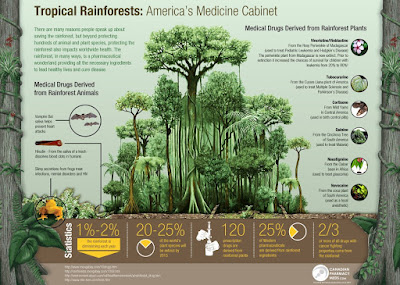Congratulations to all Grade 12's for making it to commencement - this is an incredible achievement, even if it doesn't feel like it =) Enjoy crossing the stage tonight.
Today's class focused on the importance of forests, as well as the way that forests are evident in our 'medicine cabinets'. There is immense knowledge and resources in our rainforests, and it is important that they remain protected.
We also talked about using forests as a way for improving general health, and explored the Japanese science of forest bathing - or shinrin-yoku. We discussed aromatherapy, the fact that trees communicate with each other, and general health (and food!) benefits of forests.
Before we get into the summary of today's class... check in to see if you have missed anything so far!
OVERVIEW OF THE FOREST UNIT: We have done the following...
Examined where forests are located in the world – and how they are defined (Study Guide – 130-132)
Practiced identifying different types of forests on a world map
Examined Canada’s forests (Taiga, Temperate Rainforest, Temperate Deciduous – Planet Earth)
Local Case Study – Great Bear Rainforest, California Redwoods – briefly examined notion of ‘stakeholders' - see assignment below for Rainforest simulation
Today's class Overview
Forests are a part of our everyday life. The foods we eat, the medicines we consume (like Aspirin from tree bark!) and other aspects of our daily life are all directly connected to forests. We began by discussing 6 reasons why forests are important. This article is summarized from the One Tree website.
We then discussed the fact that intensive research out of the University of British Columbia is examining the ways in which trees communicate with each other. Watch this video clip to find out more information. BBC - How Trees Secretly Talk to Each Other and if you are interested, listen to the BC researcher, Suzanne Simard's,TED talk: How Trees Talk to Each Other to get more information.
Last, we looked at the practice of Shinrin Yoku - the Japanese art of forest bathing. We discussed the elements of the practice, as well as reasons why this would be a popular and state-encouraged practice in Japan. We linked this physical geography study to the idea of urbanization, anxiety and stress levels. We talked about using our 5 (or 6!) senses to ease our anxieties and promote our own healthy well-being.
Here is the article summary of Forest Bathing, as well as the Questions that went along with it. Ensure that questions are complete. The infographic below will help you answer questions about the medicinal properties of Tropical Rainforests.

For Friday's class, Block 2 will examine Mountain Gorillas and the Virunga National Forest in the Congo, and Blocks 3 and 4 will be at Woodstock.
Today's class focused on the importance of forests, as well as the way that forests are evident in our 'medicine cabinets'. There is immense knowledge and resources in our rainforests, and it is important that they remain protected.
We also talked about using forests as a way for improving general health, and explored the Japanese science of forest bathing - or shinrin-yoku. We discussed aromatherapy, the fact that trees communicate with each other, and general health (and food!) benefits of forests.
Before we get into the summary of today's class... check in to see if you have missed anything so far!
OVERVIEW OF THE FOREST UNIT: We have done the following...
Your assignment for this unit is the "1 pager" - the creation of an Infographic on a forest case study of your choice. This is due next Tuesday (Friday, optional deadline)
You will also have a Quest on Forests on Tuesday, June 11, 2019.
Today's class Overview
Forests are a part of our everyday life. The foods we eat, the medicines we consume (like Aspirin from tree bark!) and other aspects of our daily life are all directly connected to forests. We began by discussing 6 reasons why forests are important. This article is summarized from the One Tree website.
We then discussed the fact that intensive research out of the University of British Columbia is examining the ways in which trees communicate with each other. Watch this video clip to find out more information. BBC - How Trees Secretly Talk to Each Other and if you are interested, listen to the BC researcher, Suzanne Simard's,TED talk: How Trees Talk to Each Other to get more information.
Last, we looked at the practice of Shinrin Yoku - the Japanese art of forest bathing. We discussed the elements of the practice, as well as reasons why this would be a popular and state-encouraged practice in Japan. We linked this physical geography study to the idea of urbanization, anxiety and stress levels. We talked about using our 5 (or 6!) senses to ease our anxieties and promote our own healthy well-being.
Here is the article summary of Forest Bathing, as well as the Questions that went along with it. Ensure that questions are complete. The infographic below will help you answer questions about the medicinal properties of Tropical Rainforests.

For Friday's class, Block 2 will examine Mountain Gorillas and the Virunga National Forest in the Congo, and Blocks 3 and 4 will be at Woodstock.
Comments
Post a Comment